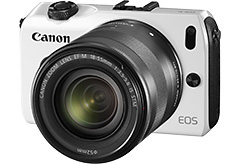In Lesson 9, I will explain how framing affects the impression of your photos. If you intend to start using a mirrorless camera, or have just purchased a new camera, this series of articles provide easy-to-understand lessons on techniques for capturing charming photos using the EOS M, which boasts high image quality and simple operability. By learning the basics of cameras and photography, you will be able to produce the shots you want easily! (Photos by: Yuji Ogura, Written & Organized by: Camera Biyori Editorial Department)

Q: How does framing affect the impression of your photos?
A: Framing refers to determining the way the subject is positioned within the frame. There are three ways of framing, "vertical," "horizontal," and "square." The ratio between the length and width of a frame is called "aspect ratio." Each of these three types gives a different impression, so you should choose one with the best balance according to the subject.
Framing
Here, let's learn about some typical ways of framing: vertical, horizontal, and square.
Photographing horizontally = Holding the camera horizontally

Allowing the viewer's attention to move horizontally, this technique makes it easy to express the flow of time. The subject is not overly emphasized, and the resulting image generally gives a subdued impression.

Holding the camera horizontally. Place the lens on your left hand palm to secure grip.
Photographing vertically = Holding the camera vertically

The subject tends to stand out, giving a subjective impression that strongly conveys the intention of the photographer.

Holding the camera vertically. Weight of the camera is almost completely on your left hand.
Photographing in a square format = Setting aspect ratio to 1:1

The viewer's attention is naturally directed to the centre, adding stability to the composition. This method of framing helps to create well-balanced shots.

Holding the camera horizontally while the aspect ratio is set to 1:1. Note that the image on the rear LCD screen is displayed in the 1:1 settiing.
What is aspect ratio?
Aspect ratio refers to the ratio between the length and width of a photo. As with 35mm films, the most common format is "3:2." On the menu screen of the EOS M, you can change the aspect ratio setting to "4:3," "16:9," or "1:1."

Select "Aspect ratio" from the menu screen.

On the EOS M, you have four aspect ratio options to choose from: "3:2," "4:3," "16:9," and "1:1."

Canon's first mirrorless camera, the EOS M, comes in four colour variations (black, red, white, and silver) so you can pick your favourite!

Ogura's work in photography expands from shooting photographic works to development and printing films. He is one of the tutors at the "Camera Biyori Photography School". He started his career as an engineer at a film laboratory and later establishes his own "mogu camera" lab. He also runs the "mogu sun" portrait studio.

Camera Biyori is a Japanese photography magazine introducing charming photos and daily joy with cameras. Suggesting fun activities relating to cameras and photography, Camera Biyori editorial department also offer the "Camera Biyori Photography School" to recommend its readers to engage in photography and have fun.
Published by Daiichi Progress Inc.

































